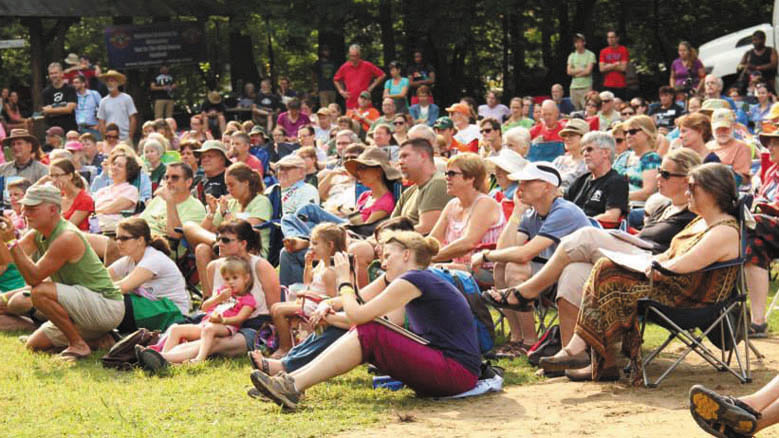
Section headings are from Wild Geese: Selected Poems by Mary Oliver.
Like lines and stanzas that spill from a prodigious poet, certain characteristics of Friends practices began to fit effortlessly together for me in 2011 at the first Wild Goose Festival held in Shakori Hills, North Carolina. There, “at the intersection of justice, spirituality, art, and music,” where people, most of whom identified as Christian, gathered to experience the Holy Spirit, I saw the gift that a particular practice, developed and expanded by Quakers, may be to the wider world.
“You do not have to walk on your knees”
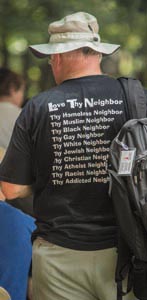 My awareness of the role of Quakers started to form during “Beer and Hymns,” an activity shared with several young adult Friends. It continued to grow during a movement workshop in which I helped an aging Walter Wink up from the ground. But it wasn’t until I heard the words of Phyllis Tickle, an energetic religious professor and author, that the pieces really began to flow together. She heralded the coming time as one in which the human race will be radically changed. Referring to mainstream religion, she emphasized the leap involved in completing the Trinity by embracing Spirit. Pointing to the change which coincided with Jesus’s life and the birth of Christianity and every 500-year period since, she spoke about the emerging church needing to powerfully reinvent itself now, to move more toward neo-monastic, missional, hyphenated, non-hierarchical, non-institutional, social justice focused faith communities. At the end of Tickle’s’ talk, an audience member moved to the microphone, introduced himself as a Friend, and asked, “Have Quakers been emerging for 300 years?” Tickle answered, “You betcha!” And we Friends and our practices continue to emerge.
My awareness of the role of Quakers started to form during “Beer and Hymns,” an activity shared with several young adult Friends. It continued to grow during a movement workshop in which I helped an aging Walter Wink up from the ground. But it wasn’t until I heard the words of Phyllis Tickle, an energetic religious professor and author, that the pieces really began to flow together. She heralded the coming time as one in which the human race will be radically changed. Referring to mainstream religion, she emphasized the leap involved in completing the Trinity by embracing Spirit. Pointing to the change which coincided with Jesus’s life and the birth of Christianity and every 500-year period since, she spoke about the emerging church needing to powerfully reinvent itself now, to move more toward neo-monastic, missional, hyphenated, non-hierarchical, non-institutional, social justice focused faith communities. At the end of Tickle’s’ talk, an audience member moved to the microphone, introduced himself as a Friend, and asked, “Have Quakers been emerging for 300 years?” Tickle answered, “You betcha!” And we Friends and our practices continue to emerge.
The following day, Leo Brunnick, founder and chief executive of Patheos, an online destination for global dialogue about religion and spirituality, spoke of the logarithmic rate of technological change. He illustrated with a few examples: brain alpha waves are being used to move objects; human faces are being transplanted; aging is being ceased and reversed in mice; the genome project took two years to map the AIDS virus and, more recently, only 32 hours to map the SARS virus. This change will further accelerate like grains of rice multiplying in the law of exponential growth, where doubling 1 exceeds 1,000 by the eleventh turn, 1,000,000 by the twenty-first turn, and 1,000,000,000 by the thirty-first turn. Brunnick put this rate of change, with technology impacting medicine and other sciences, in the context of religion: “We need to ask, ‘What more will we take out of God’s hands?’”
It became apparent to me that our species will undergo heightened anxiety from this accelerating rate of change, and also from the economic and ecological challenges of rampant extinction and gross wealth disparities. Brunnick spoke about the way that groups tend to intensify and become exaggerated forms of themselves during times of rapid change; for example, fundamentalists can become more fundamentalistic, atheists more atheistic. In such demanding conditions, it may become more challenging to find that which unifies us as Quakers.
Moral questions will become more complex when the conversation shifts, for instance, from whether gays and lesbians can marry to whether clones and cyborgs can be clergy or senators. To reach across the resulting divides, a widespread and deep level of spiritual grounding will become imperative. The population will need the extraordinary moral fortitude that is central to servant leadership. Robert K. Greenleaf, a Friend credited with coining the phrase “servant leadership,” said that the best test is to ask: “Do those served grow as persons; do they, while being served, become healthier, wiser, freer, more autonomous, more likely themselves to become servants?”
I would replace the word “autonomous” with the word “whole” in Greenleaf’s query. As challenges become more complex and demanding, the collective intelligence of groups will be more critical to our planet’s survival. Singular individuals in leadership roles may not suffice, as one person often does not have the needed breadth of wisdom or degree of trust which a group is better equipped to offer. But, perhaps, with new methods made possible by the open capacity of the Internet and cells of faithful groups who continually hold each other accountable to a higher good, the church can effectively unify, and humanity can become one and fully recognize its interdependence with all of creation.
“You only need to let the soft animal of your body love what it loves”
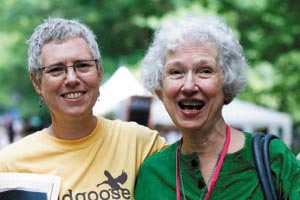
At the time of the 2011 Wild Goose Festival, I was studying the effects of anxiety on individuals and systems in an attempt to countermand the related symptoms (or the condition itself). On a macro-level, I wanted to understand how larger groups can break through the apocalyptic tension felt in the world today. On a more personal level, I wanted to alleviate my own anxiety, the result of living without health insurance or other employee benefits on a gross salary of $216 per week among people with greater wealth. One saving grace during that difficult time for me was belonging to a network of communities of spiritual accountability which held its members to faithfulness even in our fear. This arrangement let us combine our small slices of truth into a larger portion and allowed us to share spiritual and material resources.
As I received the messages of Tickle and Brunnick, as I sang hymns and drank beer, as I danced with and assisted in his dementia one of the most brilliant people I knew, I was convinced that spiritual accountability, a practice I had come to know through Friends, needed to be spread like wildfire within our religious society. It also needed to be carried outward to help heal our wounded world. It provides a way to raise up good by holding those who serve and lead accountable to the highest possible outcome. To me, this practice of spiritual accountability seemed to embody a Quaker charism, an extraordinary power given by the Holy for the good of the world.
Friends believe in the inner goodness of every person and in the fuller knowledge and experience of our shared goodness when we intentionally seek, share, and act together on behalf of a greater good. We recognize that gifts conferred upon a community are to be nurtured by the community in service to the world. We acknowledge that leadership can arise through any one of us. The combination of these beliefs leads us to practice the power of the collective. These are the building blocks of collective intelligence. Might such a group process, which uses these practices in service to the Holy, be a Quaker charism?
Friend Parker Palmer, an author, educator, and activist, has shared the Quaker clearness process with the world through his writings and workshops. Many are well served by his work. Yet, clearness is just a first step in a leading. It is possible to hear a sacred call and be found clear to proceed and yet still forsake it because of the noise of our fears. We might abandon it for the promise of power, privilege, or the consumer culture that encircles us. A spiritual accountability process can offer a centripetal force to pull us back toward our sacred path.
“Tell me about despair, yours, and I will tell you mine”
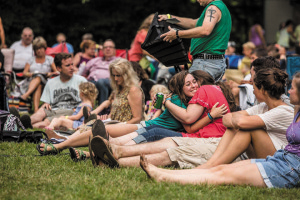
An on-going spiritual accountability group which both supports and challenges us can be a much more powerful force for long-term faithfulness than a brief clearness committee. Because it is a concerted and continuous commitment, each individual can come to intimately know his or her own and other members’ strengths and opportunities for growth. This level of commitment allows members to accompany one another in the field while offering ministry.
I call this kind of relationship “peer spiritual accountability,” and it has offered me and others fuller portions of truth at times when it was most needed. In addition, the practice of spiritual accountability has at times abated my anxiety and, at other times, actually acted as an antidote to the formation of anxiety. It surely was an important resource that furthered the ministry carried by the six members of a peer group which met monthly for about seven years.
We were a self-appointed group serving in various ministries. A structured and agreed-upon spiritual accountability process helped us midwife each other’s on-going calls and venture outside our comfort zones. Our main queries were: “What does faithfulness ask of Spirit?” and “How will we respond?” We took turns, rotating our focus on two members for each two-hour monthly session. These sessions opened with a period of worship and closed with a self-assessment of our attention to our guiding principles. Deep listening and attention to the presenter’s words, body language, changes in skin tone such as blushing or flushing, and the movement of the Spirit in the gathered group all guided our waiting worship. The attention prompted questions and occasional observations from those of us who were present to the presenter.
Our overall intent was to help the focus person find the way to the feet of the Inward Teacher, to confront the Source of Being, to directly encounter the Guide. As such, questions or observations were pointed in that direction rather than toward answering questions we might have or toward solving problems. Being inextricably committed, irrevocably vulnerable, and consummately loving were prerequisites for the experience offering its fullest gifts. In those sacred encounters, some of us took notes for the presenter and other group members to reference afterwards. Like a set of flip cards that create a movie when displayed in sequence, these notes showed the growth in the Spirit, as well as the places where we had yet to venture—individually and as a group.
Other groups appointed by our monthly meetings provide a different kind of accountability structure. As a member of Central Philadelphia (Pa.) Meeting, I’ve participated in a “spiritual accountability group” (SAG), with its primary functions being to assist in accountability:
- between the ministry and the One who calls us to ministry
- between the ministry and those served by it
- between the minister and the faith community
I have tried to incorporate coaching components into this SAG process, so that we will hold one another accountable not only to Spirit but also to project progress (both the outcomes and the manner in which those outcomes are achieved).
Some of us have also engaged in shorter term groups of peer accountability. One group used check-in telephone calls every few weeks; another worked as a team to create a six-month program on Spirit-led social action. Together, these interlocking groups formed a safety net; members knew they were being held both by Spirit and by a community of friends. These groups served us and others in unimaginable and often indescribable ways. They midwifed plays, workshops, courses, plenary talks, articles and books, and service in urban schools, prisons, conference centers, on committees and boards, and amid families in need. They helped us, with Divine assistance, to co-create a better world.
“Whoever you are, no matter how lonely”
The world yearns for greater connection. I often hear Friends expressing a need for spiritual accountability on the local meeting level. We held interest groups on releasing ministry at this year’s Friends General Conference Gathering and Philadelphia Yearly Meeting’s annual sessions. We heard many participants speak of the need for love, respect, trust, vulnerability, honesty, witnessing others on the path, and a sense of safety. All of these relationship characteristics deepen and become more nuanced and intimate over time as we continuously devote ourselves to each others’ faithfulness. They become reciprocal when we use a peer process for mutual spiritual accountability.
What is needed for greater spiritual accountability within and beyond the Religious Society of Friends? More of what has already begun. Trainings on peer spiritual accountability have been offered through the School of the Spirit’s one-year Way of Ministry program, Philadelphia Yearly Meeting’s nine-month Spiritual Formation program, Philadelphia’s Evergreen Worship Group training, and elsewhere. For instance, Engaging Spiritual Accountability introduced some folks to the concepts, and Practicing Spiritual Accountability was a three-month blended learning course (in-person and online) offered through Woolman Hill Quaker Retreat Center and Quaker Studies program of New England Yearly Meeting’s Salem Quarter. The course introduced a peer spiritual accountability process, established small groups for practicing the process between sessions, and shared developmental assignments, related tools, and participants’ experiences through an online classroom. So far, Quakers, Catholics, Wiccans, Mennonites, and Unitarians have benefited from these offerings.
“The world offers itself to your imagination”
The peer spiritual accountability process which formed inside the “Quaker bubble” has most naturally popped outside of it. In a world starved for community and seeking alternatives to the dominant culture, we’re asked by the Spirit to spread the good news. The spiritual accountability process and the cells of community that are formed by it create a “plausibility structure” that opens people to another way of being: one that supports the individual and the collective yearning for the Divine and encourages us to shift from an economy of mammon—marked by a scarcity mentality and material greed—to an economy of manna—marked by an abundance mentality and the formation of beneficial relationships and community.
Spiritual accountability groups invite us to break down the false boundaries that separate us. They offer the opportunity to create alternative communities that challenge the dominant paradigm. They offer the opportunity to seek not only our highest personal selves, but also sarvodaya, which in Hindi means “the good of all.” Faced with the challenges of our time, we need to evolve individually and as a species as effectively and rapidly as we can. The peer spiritual accountability model offers the antidote to separateness and reaches toward true community, the Sacred Oneness, the Sh’ma that says, “The Lord our God is one God,” and helps us know: “It is GOOD!”
I agree with Tickle and Brunnick that the changes our world is experiencing will increase in complexity and frequency in the future and require us to be more resilient individuals, groups, and societies. I believe that these peer spiritual accountability groups offer a unique democratic promise as we live into a future full of change, fear, and risk of entrenchment and division. These groups assist the individuals within them to evolve in several ways: by allowing our fullest selves to be revealed, by learning from one another, and by sharing resources that otherwise might seem scarce.
Spiritual accountability prepares us in ways we have not previously known, guided by the Guide and our shared wisdom, to leverage our diversity for the highest good. What promise the world might know if we Friends commit to share this gift with the wider world, outside the Quaker bubble! Friends have a gift for which the world is begging. Here we are, God; send us.


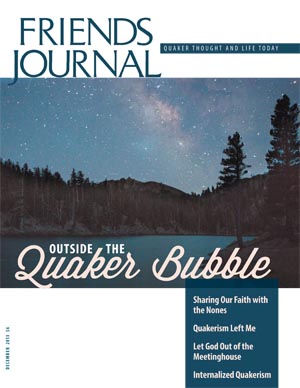
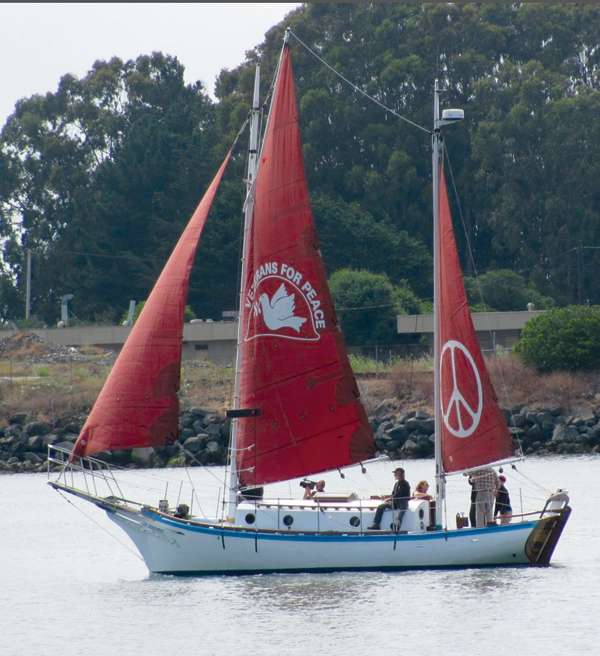
Comments on Friendsjournal.org may be used in the Forum of the print magazine and may be edited for length and clarity.